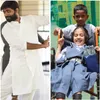Awareness and impact: how photography can catalyse change
In our second photo essay from the Kiran Nadar Museum of Art, we feature photographs by Raghu Rai and curator insights.
Launched in 2014, PhotoSparks is a weekly feature from YourStory, with photographs that celebrate the spirit of creativity and innovation. In the earlier 775 posts, we featured an art festival, cartoon gallery. world music festival, telecom expo, millets fair, climate change expo, wildlife conference, startup festival, Diwali rangoli, and jazz festival.
New Delhi’s Kiran Nadar Museum of Art (KNMA) has wrapped up a four-month exhibition titled A Thousand Lives: Photographs from 1965-2005. It features the creative works of Raghu Rai, a critically-acclaimed photographer, photojournalist and author (see Part I of our coverage here).

The black-and-white photographs reflect the realities from an earlier era, while also showing how some things seem unchanged across the years. They showcase the photographer’s artistic abilities, while also chronicling life on the streets.
“Younger visitors were captivated by the portrayal of historic India and admired Raghu Rai's work. Older visitors were filled with nostalgia, reminiscing about the era and reflecting on Rai's impact on their lives,” curator Roobina Karode tells YourStory.
The exhibition engaged a range of viewers in its rigour and display.
“Given the number of visitors expressing interest in returning multiple times, we consider the exhibition a great success,” Karode adds.

Given Rai’s expansive collection of works, it was also a challenge to present only about 300 photographs.
“Through multiple meetings and discussions with Raghu Rai and Devika Daulet-Singh, we arrived at a decision to stick to the pre-digital phase of Rai's practice,” she explains.
There are iconic political and spiritual leaders, as well as portraits of a broader spectrum of society. The exhibition was designed in the form of fluid spaces, presenting unusual juxtapositions of such photographs and provoking curiosity.
“The exhibition created a visual hide and seek, offering viewers multiple vantage points to engage with the works,” Karode says.

Photography has played a number of roles in society.
“Whether it's through photojournalism, documentary photography, or activism, photography has also been used to catalyse social and political change by raising awareness about personal issues and inspiring action,” she affirms.
From the days of pinhole cameras to mobile selfies, human fascination to capture reality and its variations has not ceased. “Rather, this fascination has increased manifold with evolving technology,” she adds.
“In such a context, analogue photographs act as anchors amidst waves of fleeting, ephemeral, digital images,” Karode describes.

As trends in photography in India, she points to variations of technology and subject matter. This includes commercial photography, retro photography, documentary photography, and portraitures.
“Some photographers subscribe to photomontage by bringing two or more subject matters together. This creates aesthetic and intellectual synergies for addressing multiple concerns,” she adds.
Staged photography involves arranging environmental setups and play-acting to simulate a moment or incident. More recent trends are driven by digital transformation.

“This includes artificially-generated images amidst dystopic settings, simulating a forecast on the fate of civilisation, where every content in the composition is outside the peripheries of the ‘real’, which advocates the idea of relativism in the perception of reality,” she describes.
The style ranges vary from realism to abstraction.
“Subjects include society, culture, politics, environment, wildlife, and more. There is a long history of journalistic photography that relies on the immediate, which probably will never become obsolete,” she adds.
From an artistic point of view, there are no limits to experimentation, transpositions, and combinations in both method and content.
“Images can mirror individual experiences while highlighting broader social narratives and cultural contexts,” Karode explains.

Another focus area is collective knowledge production and the representation of communities, cultures, and political histories through photography.
“Many photographers actively document and build up a visual database of diverse cultural heritage, advocating social change, and amplifying marginalised voices within society,” she observes.
She explains that Rai, through his rigour and commitment as a photographer, captured many transformative incidents. This was not merely as a photojournalist but as a person with deep “aesthetic empathy.”
“With a special ability to understand and excavate the ethos of a situation, Rai captured some of the most intense and evocative frames that are crucial within the history of Indian photography,” Karode describes.

“His archived works could span over a lakh images, many of which have never been seen by the public,” she says.
The exhibition focuses on the relatively lesser-known, enigmatic photo-artist and his unseen photographs.
Karode also offers words of advice for aspiring photographers. “The young and aspiring photographers are already working to build their distinct visual language,” she says.
“Aspiring photographers should focus on creating a solid body of work to begin with that can translate into a meaningful exhibition project,” Karode signs off.
Now what have you done today to pause in your busy schedule and harness your creative side for a better world?












(All photographs were taken by Madanmohan Rao on location at the exhibition.)







![[YS Exclusive] SquadStack debuts AI-driven CX platform featuring humanoid AI agent](https://images.yourstory.com/cs/2/fe056c90507811eea8de27f99b086345/CopyofNewPPTTemplates-2025-03-05T190037-1741181509927.jpg?mode=crop&crop=faces&ar=16%3A9&format=auto&w=1920&q=75)



